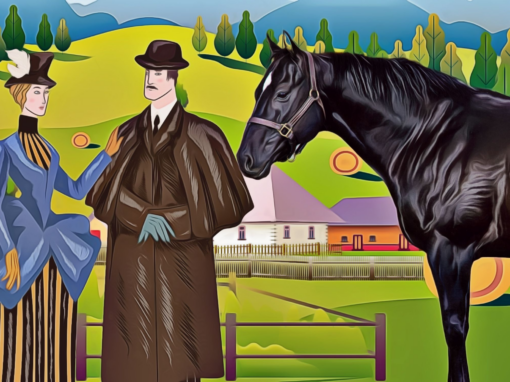Horse Riding Helmets – Yes Or No
As an instructor, do you insist that all beginner riders have approved helmets when they ride?
We have all heard riders complain that helmets are too hot, too uncomfortable, and don’t give the protection that they are supposed to.
Riders may also say that helmets are for jumping or dangerous activities and even that they don’t plan to fall off!
Some may even say that as they are over 18 and legally an adult, they don’t want to wear a helmet and that it is their choice.
But remember that the primary purpose of a helmet is to safeguard the rider’s head against potential injuries in the event of a fall or impact.
Head injuries can be severe and life-altering, making the protection offered by helmets critical and a property-fitted helmet provides a cushioning barrier that absorbs and disperses the force of an impact, reducing the risk of head trauma.
Let’s look at the scientific research. In a Queensland University Research Project of 187 riders, they found that traumatic brain injury was the most common injury sustained from falls from horses, and riders who wore helmets had significantly less severe traumatic brain injuries and shorter stays in hospital compared with those who did not.
That is just one of the many research projects that examined accidents with horses and came to the conclusion that helmets should be worn.
Many competitions and also occupations within the horse industry have made helmets mandatory and almost all states and territories in Australia have legislated that new and beginner horse riders are to wear helmets.
I haven’t found any research that shows helmets for horse riding are not effective, but if you know of any, please let me know.
Your role as an instructor (whether you are paid or not) puts you in the position of being ‘the expert’ and having a duty of care to your riders.
Social influence can encourage many riders to wear helmets, so if you and all your students wear helmets then it becomes ‘normal’ and when a new rider comes to you for lessons, they are more likely to wear a helmet without the excuses they have previously had.
Many riders also admit that they feel safer because they have a helmet on so they can focus on their lessons and the enjoyment they feel from horse riding.
So avoid the risk. Make sure you provide correctly fitting helmets for your riders, as an instructor you have a duty of care to keep your students safe.
Yes, you will need a variety of sizes, but these are a cost of doing business and can be used by multiple individual riders within the same day or the same week and you can allocate this cost over several years.
So let’s celebrate the bond between horse and rider without compromising safety.
Make the use of helmets for you and your students a non-negotiable element of responsible riding and responsible teaching.
That way we can all enjoy the magic of riding horses for many years.
Have a safe ride!
Glenys 🙂
International Horse College











Helmets are an extremely important safety factor to riding. Horses can be unpredictable so claiming that they wont fall off is not an excuse to not wear a helmet. Wearing one can, and more than likely will save the rider from suffering a severe head trauma leaving possible permanent damage. Helmets should be mandatory when on the horse at all times no matter the horse or discipline.
I agree that all who ride horses should wear a helmet. Not only does wearing a helmet protect your head and brain from what could be a severe injury, even death, but it even provides a bit of protection from the sun. No matter how “bomb proof” anyone thinks their horse is, no matter how strong their connection with their horse, they should always wear a helmet. No one can control a 500 kilo horse, who also has a mind of their own. Many times, it’s when you least expect it, that a horse throws you off their back, even if you’re just riding around in a round pen at a walk.
I agree that all beginners should definiety wear a helmet, and it is a good habit to have (putting a helmet on every time you ride)
I agree with people wearing helmets, so they enjoy their safety and their riding so they don’t get hurt.
I strongly believe that all riders, regardless if they are a beginner or a professional should wear a helmet. In the case of a freak accident and someone falls off, the chances of brain damage is much lower with a helmet on than off. All horses are unpredictable, even if someone says that horse is “bomb proof” something could happen causing the rider to fall of, even if it isn’t the horse’s fault the rider could badly injured them self without a helmet which can lead to long term injuries.
Helmets are one of the most vital riding equipment for our safety, horses are animals that have a mind of their own, no matter how safe or bomb proof you think your horse may be riding without a helmet is extremely dangerous and life threatening. They might be uncomfortable to wear but they are the only thing that can save your life when a 600kg animal throws you into the ground. Horses are very unpredictable when you least expect them to be, so always make sure you are protecting yourself from the danger that may await you.
Young students just starting out should always wear an approved helmet and it is more important for a beginner especially because they don’t have the experience. If you don’t wear a helmet, you are risking a serious injury or death, a helmet is a small price to pay for your life. Helmets should be required for everyone, no matter what discipline, experience, time, or how ‘bombproof’ your horse is.
I agree that approved helmets should be worn whilst riding a horse. Helmets are an extremely valuable part of horse safety. They protect you from head injuries if you fall off or any other accident occurs. Even if the horse you are riding is very quiet doesn’t mean that they are ALWAYS quiet. Anything could happen at anytime causing an unpredictable situation. Helmet should be worn while riding to prevent serious injuries but it is up to the rider if they want to take the risk.
I highly agree with this article, all riders should wear a helmet regardless of Age and riding ability. Anyone can experience a dangerous fall although a helmet will decrease chances of concussions and brain damage. Accidents happen, even if the horse trips over, the helmet can save your life, even if your fall and get dragged your very much more likely to survive with a helmet ( that is approved and up to date with todays standards )
There are many reasons or excuses for not wearing helmets, yet research shows that a properly fitted helmet can drastically reduce the risk of head injuries in the equestrian industry.
I say Yes to wearing helmet it dose not matter how old u are any thing could happen any time.
Great to hear from you Nicole and to know that you are a supporter of wearing a helmet
🙂
Helmets are a MUST when riding!! Horses are unpredictable and have a mind of their own. Wearing a helmet will help with serious injuries when something has happened. You are more likely to have a faster recovery when wearing a helmet. Also whilst you are riding you may not notice but the sun would burn up your head if you were not to wear a helmet. These results could end in heat stroke. Therefore there are many reasons to wear helmets and explanations.
Riding without a helmet is dangerous and irresponsible.
Wearing a helmet prevents unnecessary injury and is a baseline for horse safety.
For extra protection from the sun add a visor to your helmet adding to to protection and sun safety factor.